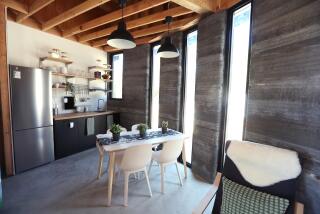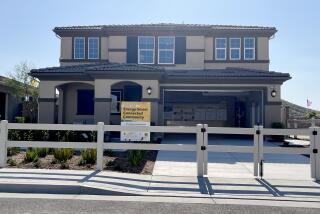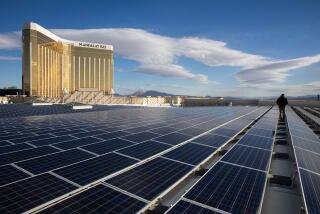Village Sheds Light on Solar Power
WASHINGTON — Take the energy of several hundred college students, mix well with donations from companies big and small, add generous dashes of inspiration and a bucketful of opportunity, and you get ... a solar subdivision on the National Mall.
It is an odd, invigorating sight: 14 diminutive houses, each meeting all of its own energy needs by harnessing the power of the sun, lined up right down the middle of the Mall’s central greensward.
Called the Solar Decathlon, the temporary village is the brainchild of a dedicated bureaucrat at the Department of Energy. With the Capitol dome and the Washington Monument as background decoration, it’s probably the best advertisement solar housing has ever had in this country.
“There are two myths about solar energy for homes,” says Richard King, the 16-year Energy Department veteran who conceived the decathlon. “One is that it doesn’t work, the other is that it doesn’t look good. We’re here to prove the opposite.”
Most of us know at some level that solar power works, that we cannot live without the sun and that, somehow, we ought to live better with it. And we know, or ought to, that solar power is a potent, clean alternative to dirty--if so far cheap--fossil fuels. Even the most outsized McMansion utilizes sunlight for heat and comfort
But in the competitive market to furnish our homes with energy, solar power has been a dud because it doesn’t deliver the amounts we demand at prices most of us would be willing to pay. And for decades solar design suffered outcast status because in reality most of the solar homes produced since the energy crises of the 1970s look like outcasts.
This is changing, though seemingly at a snail’s pace--renewable energy sources such as the sun account for only 4% of the nation’s energy consumption. Still, the technology for transforming sunlight into electrical energy gradually has improved, and prices are coming down. Awareness is slowly spreading about the advantages of “passive” solar design; for example, situating a house to take proper advantage of prevailing sunlight and winds.
The Solar Decathlon is intended to speed up the pace of change, and it may well succeed. It is guaranteed to sharpen the awareness of anyone who visits the village, for it is a spirited outpouring of mental and physical energy.
Each house was designed and built by a collegiate team, mainly architecture and engineering students. The teams, each drawn from different institutions, had to follow a few basic rules concerning size (of necessity, very small), height (18 feet, tops) and internal uses and fixtures (kitchen, bedroom, living-dining area, bathroom, laundry facilities, home office).
In all other respects, the teams were free to follow their own inclinations, though costs were a big factor. The figures I heard most often during visits to the site were $240,000 and $250,000, and these did not include major equipment donations from local and national companies or thousands of hours of student labor. Clearly, fund-raising was a big deal for the past two years in 14 college towns.
The proof of all this work will come in the testing. Each house has 32 monitors, measuring things such as the efficiency of appliances; interior comfort (a constant temperature of 72 degrees is required); hot water for bathing, laundry and dishwashing; lighting quality; home business operation; power generation for an electric car; and overall energy efficiency.
Information from these monitors will be wirelessly fed to a databank every 15 minutes (and can be checked at www.solardecathlon.org). At the end of the houses’ stay on the Mall, the one with the highest point total (100 points max per test) will win the monitored part of the competition. Three other tests, however, will be judged by humans: graphics and communication, presentation and simulation, and design quality.
The design test, deservedly, gets a little more weight than the others: 200 points. “Architecture is just so important,” explains King. “We need the architects of the world to learn about solar energy and start using it.”
Basically, there are two strategic approaches on view on the Mall. One emphasizes marketability: designing a solar house that looks like any conventional one. The other stresses a more integrated, innovative approach: designing a solar house that looks more like the future than the past.
More to Read
Inside the business of entertainment
The Wide Shot brings you news, analysis and insights on everything from streaming wars to production — and what it all means for the future.
You may occasionally receive promotional content from the Los Angeles Times.










